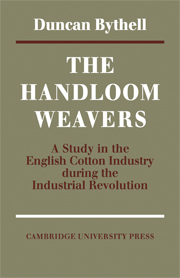Book contents
- Frontmatter
- Contents
- Preface
- Introduction
- Map of the weaving towns and villages of north-east Lancashire in 1821
- 1 Problems and sources
- 2 The organization of the industry
- 3 The labour force
- 4 The coming of the powerloom
- 5 Wages: (I) The piece-rate
- 6 Wages: (II) Earnings and the standard of living
- 7 Public opinion and the handloom weavers
- 8 Organized industrial action among the cotton handloom weavers
- 9 The weavers and radical politics
- 10 The problem of poverty
- 11 Displacement and disappearance
- Appendix 1 Some piece-rate series
- Appendix 2 The piece-rate and the price of food
- Appendix 3 G. H. Wood's estimates of average weekly earnings
- Bibliography
- Index
8 - Organized industrial action among the cotton handloom weavers
Published online by Cambridge University Press: 07 October 2011
- Frontmatter
- Contents
- Preface
- Introduction
- Map of the weaving towns and villages of north-east Lancashire in 1821
- 1 Problems and sources
- 2 The organization of the industry
- 3 The labour force
- 4 The coming of the powerloom
- 5 Wages: (I) The piece-rate
- 6 Wages: (II) Earnings and the standard of living
- 7 Public opinion and the handloom weavers
- 8 Organized industrial action among the cotton handloom weavers
- 9 The weavers and radical politics
- 10 The problem of poverty
- 11 Displacement and disappearance
- Appendix 1 Some piece-rate series
- Appendix 2 The piece-rate and the price of food
- Appendix 3 G. H. Wood's estimates of average weekly earnings
- Bibliography
- Index
Summary
In common with other workers in industries organized on a capitalist, private-enterprize basis, the cotton handloom weavers' most immediate and direct method of putting pressure on their employers lay in some form of ‘industrial’ action. A combination of workmen, using the ultimate sanction of a strike, is the ‘normal’ retaliation against any threatened deterioration in the conditions of work or fall in wages, regardless of whether or not the employers seem directly responsible for it. At a time when parliament was slow to act, and when political reform offered only a vague panacea, the most obvious response to some sudden challenge was prompt local action against those masters whose decision to lower wages had thrown down the challenge in the first instance.
As the handloom weavers suffered many wage reductions, one might expect them to have turned frequently toindustrial action in their efforts to halt the decline. Yet it was a matter of general comment among contemporaries that they seldom did so. The docility of the cotton weavers was often contrasted with the violence of the factory spinners, who in the 1820s and 1830s were usually regarded as the most ardent of trade unionists.
- Type
- Chapter
- Information
- The Handloom Weavers , pp. 176 - 204Publisher: Cambridge University PressPrint publication year: 1969

